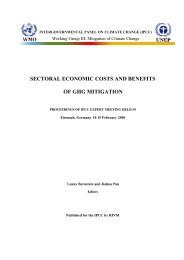Pacific Islands Environment Outlook - UNEP
Pacific Islands Environment Outlook - UNEP
Pacific Islands Environment Outlook - UNEP
You also want an ePaper? Increase the reach of your titles
YUMPU automatically turns print PDFs into web optimized ePapers that Google loves.
12<br />
STATE OF THE ENVIRONMENT<br />
Figure 1.3: Percentage of <strong>Pacific</strong> populations with access to safe water<br />
Cook <strong>Islands</strong><br />
FSM<br />
Fiji<br />
Kiribati<br />
Marshall <strong>Islands</strong><br />
Nauru<br />
Niue<br />
Palau<br />
PNG<br />
Samoa<br />
Solomon <strong>Islands</strong><br />
Tokelau<br />
Tonga<br />
Tuvalu<br />
Vanuatu<br />
Source: UNDP (1996)<br />
99%<br />
30%<br />
92%<br />
65%<br />
50%<br />
90%<br />
100%<br />
88%<br />
23%<br />
70%<br />
61%<br />
100%<br />
100%<br />
100%<br />
87%<br />
occurrences of cholera. Often with poor waste disposal<br />
and inadequate well-head protection, groundwater is<br />
highly susceptible to contamination and water-borne<br />
organisms. Pumping from the freshwater lens needs to<br />
be carefully monitored and controlled in order to provide<br />
warning of impending saltwater intrusion and to test<br />
water quality for bacteria counts, chemical residues and<br />
total dissolved salts. In Wallis and Futuna, households on<br />
Futuna have free access to water but it is not treated, and<br />
disease is noted. By contrast, on Wallis, where<br />
households are paying for access to water that is treated<br />
and analysed on a regular three-month basis, no disease<br />
is noted (Goepfert 1998).<br />
Water quality in the high islands is usually acceptable<br />
by WHO standards, although some problems occur in<br />
villages in flooded riverine and estuarine environments,<br />
where, though the water quality may be poor, it is still<br />
potable to the local populations. In Guam, groundwater<br />
provides over 75 per cent of water needs. Overuse or<br />
overpumping of this resource has resulted in increasing<br />
chloride concentrations as a result of saline intrusion,<br />
making it unfit for drinking. Further evidence of<br />
increasing anthropogenic contamination of Guam’s<br />
aquifers is demonstrated by the increasing nitrate levels<br />
(GEPA 1998).<br />
Pollution and enrichment of fresh water occurs to<br />
varying degrees throughout the region. It is difficult to<br />
give a precise assessment, as there are inadequate water<br />
quality data available. The lack of water resource data in<br />
most island countries often means that major<br />
development is implemented without knowledge of the<br />
practical implications for the environment and the<br />
resource. Provision of expert water quality monitoring<br />
and analytical services is expensive and difficult for the<br />
widely separated islands of the <strong>Pacific</strong>.<br />
The UNDP report (1996) on The State of Human<br />
Settlements and Urbanization in the <strong>Pacific</strong> <strong>Islands</strong> –<br />
prepared for the United Nations Conference on Human<br />
Settlements (Habitat II) – provides information on<br />
<strong>Pacific</strong> populations with access to safe water, as shown<br />
in Figure 1.3.<br />
It should be noted that many of the data are derived<br />
from national population censuses, which, though among<br />
the most reliable of sources, are still largely interpretive.<br />
There are therefore certain problems in using some of<br />
the census data. Most importantly, differences in<br />
coverage rules, the scope of the censuses, definitions,<br />
and procedures for collecting and processing data all<br />
make it difficult to compare results. There are compound<br />
problems in the quality of data and their interpretation.<br />
For example, whilst a high percentage of people may<br />
have access to ‘safe water’, there is no indication of the<br />
reliability of supply of the water; nor do the data reflect<br />
the marked differences in access between rural and<br />
urban settlements; nor is there a universal definition of<br />
the term ‘access’.<br />
Trends forecast to 2010<br />
Current indications are that the future outcomes<br />
predicted by the World Bank (1995) study were<br />
reasonably accurate, namely that, for urban areas in Fiji,<br />
Solomon <strong>Islands</strong> and Samoa, service quality and<br />
environmental conditions for water supply would<br />
decline, with a corresponding increase in health risks<br />
and productivity losses. In Samoa concern over<br />
pollution of groundwater from inadequate waste<br />
disposal systems (domestic and commercial, liquid and<br />
solid waste) has led to plans for the development of a<br />
sewage disposal system for Apia, which will be the first<br />
such facility in the country.<br />
Despite the optimistic statistics in the 1994 and 1996<br />
UNDP reports, there continue to be shortages of water<br />
supply in many <strong>Pacific</strong> island countries. There is an<br />
obvious need to provide a secure continuous supply. The<br />
problem is more one of economics, health and hygiene,<br />
and overall water resource management, than just the<br />
alleviation of thirst. In particular there is a need to<br />
‘drought proof’ many regions which are prone to seasonal<br />
and cyclical shortages of supply. More importantly, in the<br />
region there are many areas that have adequate quantities<br />
of water but of poor quality, leading to health problems.

















